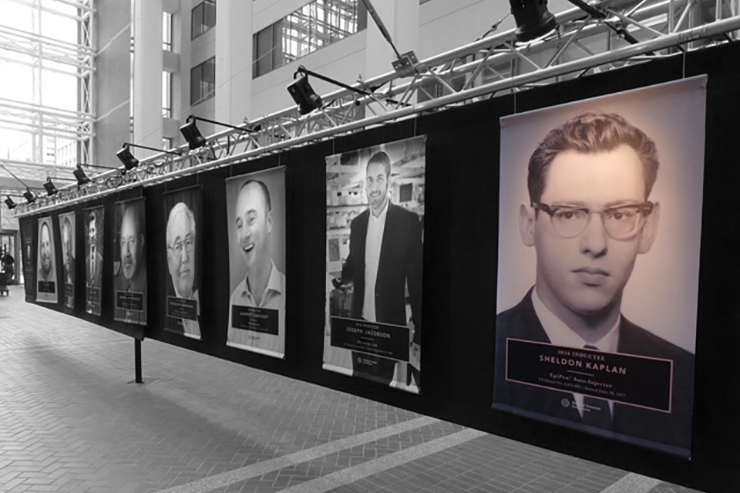Northeastern alumnus the genius behind life-saving EpiPen

The response to the steep increase in the price of the EpiPen—a life-saving treatment for severe allergic reactions—received a shot in the arm last week with the announcement of two legal actions.
New York’s attorney general launched an investigation into whether Mylan, the company that owns the device, engaged in anti-competitive practices in its sales to schools, and an Ohio lawyer filed a suit alleging that the rocketing price—from about $104 in 2009 to more than $600 this May—constituted price-gouging.
What would Sheldon Kaplan, a Northeastern alumnus and the inventor of the EpiPen, have made of all this?
Shel, as his wife, Sheila, calls him, did not live to see the controversy—he died in 2009 from cancer at the age of 70. But he was well aware of the huge impact his invention had on people’s lives. So was the U.S. Patent and Trademark Office, which in May inducted him into the National Inventors Hall of Fame, in Washington, D.C., noting that “since its introduction in 1980, the EpiPen Auto-Injector has saved countless lives.”
“Shel was proud to know that his invention had affected tens of millions of people, had kept them alive,” says Sheila, over the phone from her home in Clearwater, Florida. Serving him tea in her kitchen on their third or fourth date, when she was 24 and he was 30, they shared their life goals. “I want to do something that’s going to leave the world a better place than when I got here,” he told her. “Being an engineer working in medical products, I think I can do that.”
“He really did accomplish what he wanted to do,” says Sheila. “That’s a sort of miracle.”
Road to a miracle
The road to that miracle began at Northeastern.
Born on June 6, 1939, in Everett, Massachusetts, Shel Kaplan, E’62, “always wanted to be an engineer and to go to Northeastern,” notes his son, Michael, by phone from his hometown of Coralville, Iowa.
“He was very analytical but also very creative,” says Michael. “He could deconstruct and fix any problem if he understood the mechanics.” Computers, medical devices, model railroads, even, literally, the icing on a cake. “‘Give me a shot at it,’ he’d say. ‘I’m an engineer.’ My father was a maker before that was how people described themselves on Twitter.”
One of Shel’s co-ops was cutting the fabric at a nearby company that made raincoats, says Sheila. “Had he not been able to go through the [co-op] program, he would not have been able to go to college,” she says. “He was very thankful for that.”
Had he not had that opportunity, the EpiPen would not have existed. The device, whose 1977 patent bears Sheldon Kaplan’s name, automatically injects a precise dose of epinephrine to block anaphylaxis, a life-threatening allergic reaction characterized by difficulty breathing, a drop in blood pressure, nausea, and shock. According to a recent study by the Asthma and Allergy Foundation of America, anaphylaxis likely occurs in about one to 50 Americans, with the rate probably closer to one in 20.
My father was a maker before that was how people described themselves on Twitter.
— Michael Kaplan, Sheldon Kaplan’s son
Shel’s childhood friend and classmate Allan Davidson, E’61, who played the trumpet in the Northeastern marching band, credits Northeastern with giving him, too, the skills to pursue a career he loved: working on propulsion systems in the Electric Boat division of General Dynamics, where he participated in the sea trials of the nuclear submarines the company built for the Navy. Over the phone from his home in Venice, Florida, Davidson recalls the motor scooters he and Shel rode in their commute to and from the university that changed their lives. “A German-made scooter called TWN, or Triumph-Werk Nurnberg,” he says, laughing.
“We spent a lot of time with Shel Kaplan’s family,” says Davidson’s wife, Harriet, who met Al when he was in his junior year at Northeastern. “Their home was like Al’s other home.”
Doing the impossible
After graduating from Northeastern with a degree in mechanical engineering, Shel moved to a suburb of Washington to work at NASA’s Goddard Space Flight Center designing and analyzing hardware for meteorological and scientific satellites. “In 1962 he got on a bus with one suitcase,” says Sheila. “His heart’s delight was to grow up and work for NASA.”
A few years later he joined Rodana Research Corporation, which later became Survival Technology, Inc. There he designed the first emergency medical kit for the Apollo Moon Missions—a terrific source of pride for young Michael, who wore a NASA tie pin on his shirt when he brought the kit to school for show-and-tell. He still has the kit: It lived in his sock drawer until he loaned it to the Inventors Hall of Fame Museum after his father’s induction and will return there after the exhibition.

Sheldon Kaplan, right, E’62, assembles the first emergency medical kit for the Apollo Moon Missions, which he designed.
At Survival Technology, where Shel worked from 1965 to 1978, he developed the PneumoPak, a pressure dressing for high-altitude reconnaissance pilots, before being charged with redesigning the company’s AtroPen (called the AstroPen by NASA), an auto-injector product with limited usefulness: It could be used only for drugs, such as Atropine, that remained stable while in contact with its stainless steel cartridge. Using glass was tricky, given its fragility, but plastics turned out to be untenable, as the vapor transmission rates through plastics were too high. “Several engineering firms that Survival Technology consulted with said using glass was just not possible because the casing would break,” says Sheila.
That didn’t stop Shel, she says. He rebuilt the AtroPen from the ground up, tempering and cushioning the glass and uniquely calibrating the spring that activated the mechanism to dispense drugs while keeping the casing intact.
First named the ComboPen, the device was initially used by the U.S. military to deliver an antidote to a new Soviet nerve agent captured by the Israelis during the Yom Kippur War. Shortly afterward, Shel reengineered the ComboPen into the EpiPen, to deliver epinephrine.
No one has been able to match his design prowess since, says Michael. It’s uncanny, he says. “To create the competition to make the EpiPen affordable, someone is going to have to solve the same problem my father solved in 1976.”
Shel left Survival Technology shortly before the EpiPen came to market and continued to develop medical equipment at global corporations including Abbott Laboratories and Baxter Healthcare.
“Shel was mathematically gifted, there was nothing he couldn’t figure out,” says Sheila.
Michael echoes the sentiment. “He was not ego driven,” he says. “He didn’t spend time trying to figure out how to do things that were flashy or that would make him famous. Every day he was committed to solving important problems that no one else could.”






